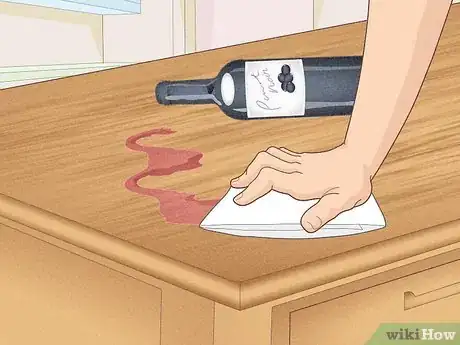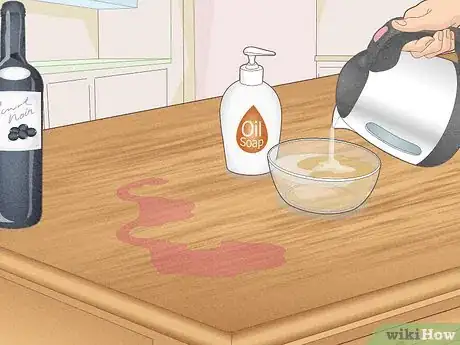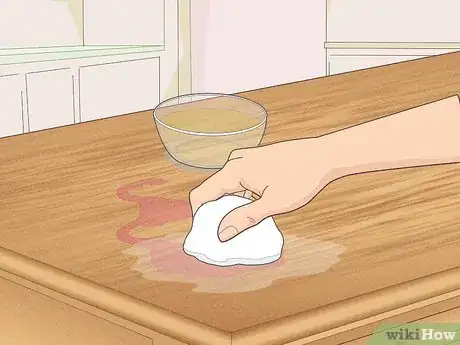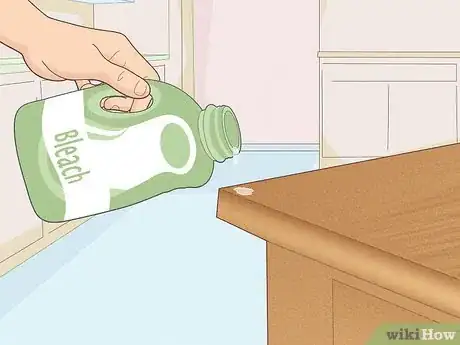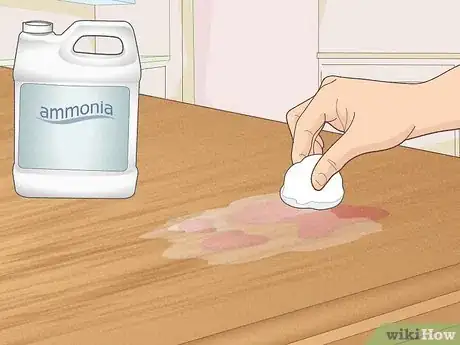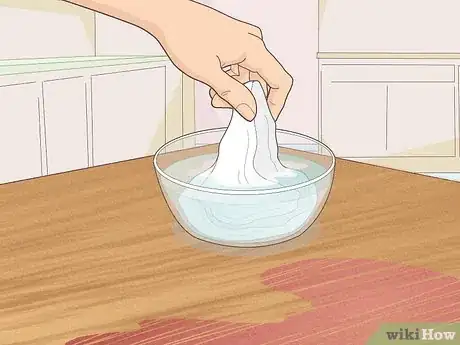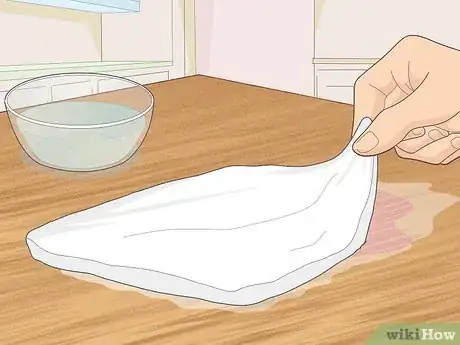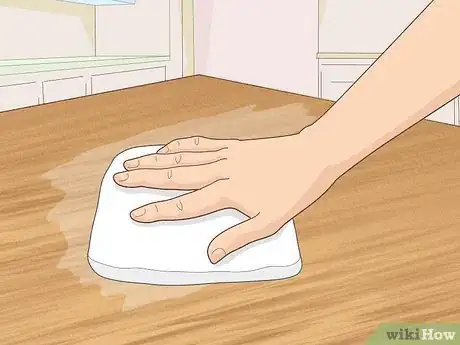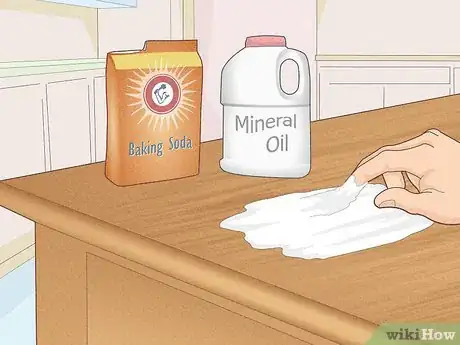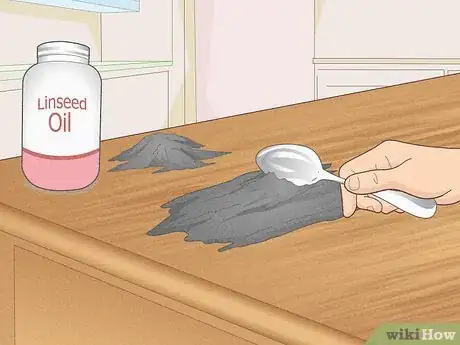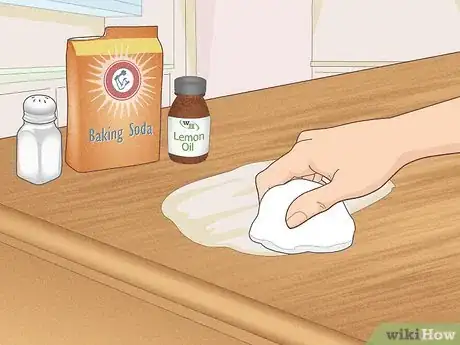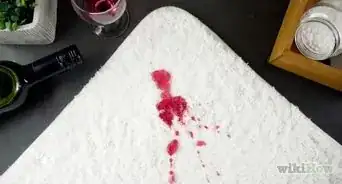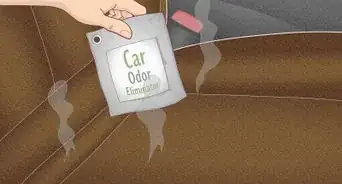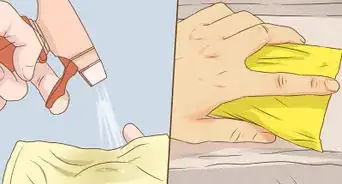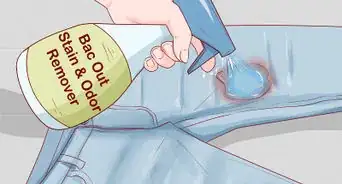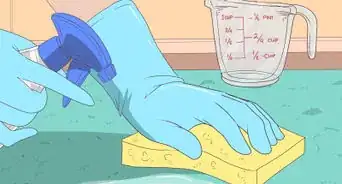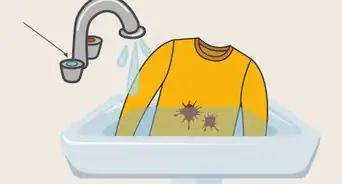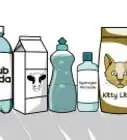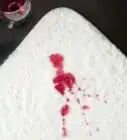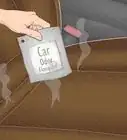This article was co-authored by Michelle Driscoll, MPH. Michelle Driscoll is the Owner of Mulberry Maids, which is based in Fort Collins, Colorado. With five years of experience, her business specializes in cleaning homes and small offices. She holds a Masters in Public Health from the Colorado School of Public Health. Additionally, Mulberry Maids has an A+ rating from the Better Business Bureau.
This article has been viewed 249,655 times.
Anyone can accidentally spill a glass of red wine during a party or a quiet evening spent at home. However, if the wine happens to land on your hardwood flooring or table, it can easily soak into and permanently stain the wood. It can be challenging to remove set-in wine stains from hardwood, but various options may be successful. It's important that you blot and clean a red wine stain as soon as possible after it occurs. A fresh wine stain is much easier to deal with than a stain that has set in for a day or two.
Steps
Blotting and Cleaning up Spilled Wine
-
1Blot the red wine spill. If the red wine hasn't fully dried on your tabletop or floor, you may be able to avoid a stain altogether. Use your kitchen faucet to dampen a paper towel or an absorbent cloth. Then, blot up the wine stain by pressing the damp towel or cloth directly onto it.[1]
- Do not wipe the wine or smear it back and forth. This will only increase the size of the stain.
-
2Mix an oil soap solution. If the wood is mildly stained, an oil soap may be all you need to remove the wine stain. Mix oil soap and hot water according to package directions. You’ll likely need to mix about 1/4 cup (59 mL) of soap with 1 gallon (3.8 L) of water.[2]
- Oil soap is readily available. You should be able to find it in the cleaning aisle of your local supermarket or hardware store.
Advertisement -
3Clean the wine stain with the oil soap solution. Once you've mixed the oil soap solution, dip a soft, dry cloth into the mixture. Wring the cloth out so that it's damp or slightly wet, and thoroughly scrub the wood where the wine has soaked in.[3] Hopefully, the stain will disappear.
- Once you’ve scrubbed the wine stain, rinse the area with a clean damp cloth or paper towel, then dry it with another clean, dry cloth.
- If you catch the wine stain early enough, this should be all you need to effectively remove it.
Cleaning Set-In Stains with Bleach or Ammonia
-
1Test bleach or ammonia on a small area first. Before you liberally apply either chemical to a highly visible surface, test the bleach or ammonia on a small area that's hard to spot. Apply only a few drops of bleach or ammonia, and let it sit for 45 minutes. This way, you won't risk further ruining your hardwood surface. If the ammonia or bleach discolors the wood, you'll need to remove the wine stain using a different method.[4]
- Never mix ammonia and bleach together, as the two will produce noxious and dangerous fumes. Choose in advance whether you will try to clean your wine stain with bleach or ammonia.
- Both bleach and ammonia are caustic substances that could damage or discolor your wooden tabletop or floor. The bleach may very well take off the existing surface coat, possibly requiring you to resurface the entire table.
- If one of these chemicals doesn't work, it's unlikely that the other will either.
-
2Apply a strong bleach to the stain. If the wine has set into the wood, clean the stained area with bleach. Depending on the size of the stain, pour about 1 tbsp (14.8 mL) of undiluted bleach on the area. Let the bleach soak for at least 45 minutes before wiping it up. If the bleach has not removed the wine stain within 45 minutes, re-apply bleach and let it sit overnight.[5]
- Use latex gloves and paper towels to wipe it up, as bleach is caustic. Immediately dispose of the towels, and rinse the bleach off your gloves.
-
3Apply ammonia to the wine stain instead of bleach. Ammonia is another potent caustic chemical that can remove a set-in wine stain from hardwood. Once you've blotted the wine stain dry, dampen a sponge or absorbent cloth with pure ammonia. Blot this onto the wine stain and let it sit. After about 45 minutes, use another damp cloth to wipe the ammonia off the wood.[6]
Using Vinegar for a Natural Solution
-
1Mix equal parts vinegar and water to form a cleaning solution. Pour the liquids into a bowl. Mix enough solution to cover your spill. For example, you might use 1 cup (240 mL) of vinegar and 1 cup (240 mL) of water.[7]
-
2Soak a rag in the solution. Saturate the rag in the mixture, and don't wring it out. You want the solution to seep into the wood and remove the stain, so your rag will need to be very wet.[8]
-
3Place the rag over the stain until it starts to lift. Check under the rag every few minutes to see if the stain is lifting. You should see that the stain is getting lighter, and the rag may show signs of the stain soaking into it.[9]
-
4Scrub the stain with another soaked rag after the stain lifts. Soak a clean rag in your vinegar-water solution, then use it to scrub the stain. Continue to scrub until the stain is gone.[10]
- If the stain isn't coming up, you can start the process over.
-
5Wipe the area clean with a fresh rag. After the stain is gone, wipe away the remaining solution with a clean, wet rag. Then, dry the area with a clean cloth.[11]
Removing Deep Stains with an Abrasive Substance
-
1Clean with a baking soda paste. Mix baking soda with mineral oil to form a thick, gritty paste. Use a clean cloth (or your fingers) to lightly rub the paste over the stain in the direction of the wood grain. Leave the paste on for 30 minutes, and remove it with a clean dry cloth.[12]
- Depending on the size of the wine stain, start out with about 2 tbsp (36 mL) of baking soda. Add the mineral oil about 1/4 tsp (1.5 mL) at a time, until the paste is thoroughly damp.
- Since baking soda is a relatively mild abrasive substance, it’s not likely to damage or scratch hardwood flooring or tables. Be sure to try baking soda before moving on to rottenstone.
-
2Make a paste out of linseed and rottenstone. Rottenstone is a very finely ground rock that woodworkers use as a polishing abrasive. Use a spoon or your fingers to mix about 1 tbsp (14.8 mL) of rottenstone with ¼ tsp (1.5 mL) of linseed oil. Lightly rub the thick paste onto the stain in the direction of the wood grain. Let the paste sit for 30 minutes, and remove with a clean dry cloth.[13]
- Only use rottenstone if baking soda wasn’t able to remove the wine stain. Rottenstone is more coarse and abrasive, and poses a larger risk of lightly scratching the wood.
- If any oil residue is left on the wood, you can absorb it by sprinkling a little baking flour over the stain.
- Linseed oil will be available at a local supermarket or hardware store. You can also find rottenstone at a hardware store or a home-supply store.
-
3Use salt and a mixture of pumice, baking soda, and lemon oil. Pour salt over the stain, then let it set for 10 minutes. Remove the salt and check the stain. If you can still see the stain, mix 1 cup (85 g) grated pumice stone, .5 cup (64 g) baking soda, and .25 cups (59 mL) lemon oil to create a paste. Spread the paste over the stain, let it set for 10 minutes, then remove it with a clean, damp cloth.[14]
- You can repeat the process until the stain is gone.
- Wipe the area dry with a clean cloth after the stain is gone.
-
4Contact a wood-care professional. If you’ve unsuccessfully tried everything you can think of to remove the stain on your own, and the stain is still set in the wood, it's likely a deep enough stain that you can't remove it yourself. Contact a wood-care professional in your area. They'll need to come to your house or apartment to inspect the stain and determine how to remove it.
- You can also contact a professional if the wine stain is large or in a very visible location on your floor to avoid the risk of potentially worsening the stain.
Expert Q&A
Did you know you can get expert answers for this article?
Unlock expert answers by supporting wikiHow
-
QuestionHow do I take red wine off of wood furniture?
 Michelle Driscoll, MPHMichelle Driscoll is the Owner of Mulberry Maids, which is based in Fort Collins, Colorado. With five years of experience, her business specializes in cleaning homes and small offices. She holds a Masters in Public Health from the Colorado School of Public Health. Additionally, Mulberry Maids has an A+ rating from the Better Business Bureau.
Michelle Driscoll, MPHMichelle Driscoll is the Owner of Mulberry Maids, which is based in Fort Collins, Colorado. With five years of experience, her business specializes in cleaning homes and small offices. She holds a Masters in Public Health from the Colorado School of Public Health. Additionally, Mulberry Maids has an A+ rating from the Better Business Bureau.
Founder, Mulberry Maids
Warnings
- Rottenstone and pumice can be highly abrasive. If you are worried about scratching up your floor or tabletop, seek professional advice.⧼thumbs_response⧽
- You may have been told that white wine can be used to remove a red-wine stain. This is false. Mixing the two together will only lighten the color and increase the size of your stain.[15]⧼thumbs_response⧽
Things You'll Need
- Paper towel
- Soft absorbent cloths
- Water
- Oil soap
- Vinegar
- Baking soda
- Linseed oil
- Mineral oil
- Rottenstone or pumice
- Furniture polish or paste wax
- Salt
- Lemon oil
References
- ↑ http://www.popularmechanics.com/home/interior-projects/how-to/a3771/4293082/
- ↑ https://www.hardwoodbargains.com/blog/what-to-do-if-youve-spilled-red-wine-on-a-hardwood-floor.html
- ↑ https://www.hardwoodbargains.com/blog/what-to-do-if-youve-spilled-red-wine-on-a-hardwood-floor.html
- ↑ http://www.spendwithpennies.com/remove-a-red-wine-stain/
- ↑ https://www.hardwoodbargains.com/blog/what-to-do-if-youve-spilled-red-wine-on-a-hardwood-floor.html
- ↑ http://www.spendwithpennies.com/remove-a-red-wine-stain/
- ↑ https://www.murphyoilsoap.com/hardwood-flooring/how-to-remove-wine-stains
- ↑ https://www.murphyoilsoap.com/hardwood-flooring/how-to-remove-wine-stains
- ↑ https://www.murphyoilsoap.com/hardwood-flooring/how-to-remove-wine-stains
- ↑ https://www.murphyoilsoap.com/hardwood-flooring/how-to-remove-wine-stains
- ↑ https://www.murphyoilsoap.com/hardwood-flooring/how-to-remove-wine-stains
- ↑ https://www.hardwoodbargains.com/blog/what-to-do-if-youve-spilled-red-wine-on-a-hardwood-floor.html
- ↑ http://www.spendwithpennies.com/remove-a-red-wine-stain/
- ↑ https://www.murphyoilsoap.com/hardwood-flooring/how-to-remove-wine-stains
- ↑ http://www.spendwithpennies.com/remove-a-red-wine-stain/
About This Article
It’s unfortunate when you accidentally spill red wine on your furniture, but luckily you can remove the stain with some household items. If the wine hasn’t dried yet, blot away as much as you can with a paper towel or cloth. Then try applying a baking soda paste made from 1 part baking soda and 1 part mineral oil. After 30 minutes remove it with a dry cloth. If you don’t have baking soda, try using equal parts water and white vinegar on the stain. For more heavy-duty stains, use bleach or ammonia to remove it. Make sure you don’t mix these 2 products since they can create dangerous fumes. Pour about 1 teaspoon of the undiluted product onto the stain. Let it sit for 45 minutes before wiping it away. To learn how to use oil soap to remove wine stains, read on!
